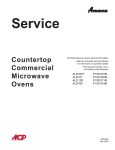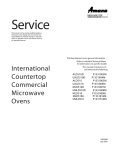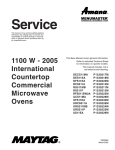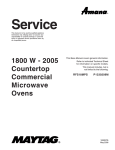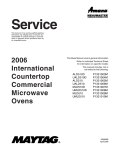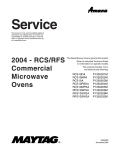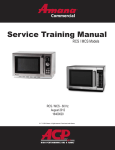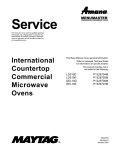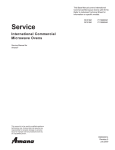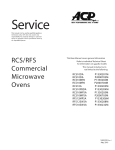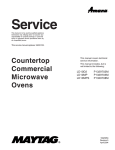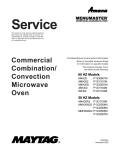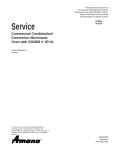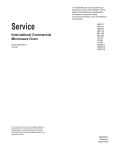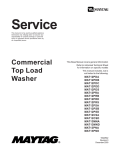Download Maytag RCS10D Operating instructions
Transcript
Service Countertop Commercial Microwave Ovens This Base Manual covers general information Refer to individual Technical Sheet for information on specific models This manual includes, but is not limited to the following: RCS10TSP2001101M RCS10DSP2001102M MCS10TSP2001103M MCS10DSP2001104M 16400009 November 2010 Important Information Important Notices for Servicers and Consumers Maytag will not be responsible for personal injury or property damage from improper service procedures. Pride and workmanship go into every product to provide our customers with quality products. It is possible, however, that during its lifetime a product may require service. Products should be serviced only by a qualified service technician who is familiar with the safety procedures required in the repair and who is equipped with the proper tools, parts, testing instruments and the appropriate service information. IT IS THE TECHNICIANS RESPONSIBILITY TO REVIEW ALL APPROPRIATE SERVICE INFORMATION BEFORE BEGINNING REPAIRS. ! WARNING To avoid risk of severe personal injury or death, disconnect power before working/servicing on appliance to avoid electrical shock. To locate an authorized servicer, please consult your telephone book or the dealer from whom you purchased this product. For further assistance, please contact: Service Support Center Contact your local product distributor or vist the Web site at www.acpsolutions.com. Recognize Safety Symbols, Words, and Labels DANGER—Immediate hazards which WILL result in severe personal injury or death. WARNING—Hazards or unsafe practices which COULD result in severe personal injury or death. CAUTION—Hazards or unsafe practices which COULD result in minor personal injury, product or property damage. 216400009 ©2010 ACP Inc. Table of Contents Important Information..................................................... 2 Important Safety Information.......................................... 4 Grounding Instructions................................................ 7 Servicing of Grounded Products................................. 8 Wiring.......................................................................... 8 Proper Grounding and Polarization of 120 Volts Wall Outlets.............................................. 8 Explanation................................................................. 8 Test Procedures (2 Methods)...................................... 8 General Test Information............................................. 8 General Information Unpacking Equipment................................................. 9 Equipment Placement................................................. 9 Radio Interference....................................................... 9 Oven Features............................................................ 9 Model Identification..................................................... 9 Service........................................................................ 9 Parts and Accessories................................................. 9 Troubleshooting Procedures........................................ 10 Electronic Models................................................. 11-14 Dial Models.......................................................... 15-16 Electronic Dial Models.......................................... 17-20 Service Information Proper Handling of Magnetron Tubes....................... 21 Magnetron Failure Mode........................................... 21 Microwave Leakage Test Equipment................................................................. 22 Procedure For Measuring Radiation Leakage.......... 22 Measurement With the Outer Panel Removed......... 22 Measurement With a Fully Assembled Oven............... 22 Record Keeping and Notification After Measurement................................................ 22 Troubleshooting Operating Instructions for Holaday HI1501, HI1510, and HI1710................................. 23 Testing Procedures.................................................. 24-25 Power Test................................................................. 26 Disassembly Procedures Disconnecting Wire Terminals................................... 27 Outer Case ............................................................... 27 Door Assembly.......................................................... 28 Door Disassembly..................................................... 28 Control Removal (Electronic).................................... 29 Control panel (Mechanical)....................................... 29 Interlock Assembly....................................................... 29 High Voltage Capacitor............................................. 30 Diode......................................................................... 31 Transformer............................................................... 31 Filter Assembly / Fuse............................................... 31 Magnetron................................................................. 31 Stirrer Motor.............................................................. 32 Magnetron Thermal Cut-Out (Mag TCO).................. 32 Cavity Thermal Fuse................................................. 32 Tray Replacement..................................................... 32 Oven Light Assembly.................................................... 32 Air Guide................................................................... 32 ©2010 ACP Inc.16400009 3 Important Safety Information ! WARNING Read the following information to avoid possible exposure to microwave radiation: The basic design of the ACP Microwave Oven makes it an inherently safe device to both use and service. However, there are some precautions which should be followed when servicing the microwave to maintain this safety. These are as follows: 1. Always operate the unit from an adequately grounded outlet. Do not operate on a two-wire extension cord. 8. Do not for any reason defeat the interlock switches. There is not valid reason for this action at any time; nor will it be condoned by Amana. 2. Before servicing the unit (if unit is operable) perform the microwave leakage test. 9. IMPORTANT: Before returning a unit to a customer, be sure to check for proper switch interlock action. 3. The oven should never be operated if the door does not fit properly against the seal, the hinges or hinge bearings are damaged or broken, the choke is damaged, (pieces missing, etc.), or any other visible damage can be noted. Check the choke area to ensure that this area is clean and free of all foreign matter. 4. If the oven operates with the door open and produces microwave energy, take the following steps: A. Tell the user not to operate the oven. B. Contact ACP, Inc. immediately. 5. Always have the oven disconnected when the outer case is removed except when making the "live" tests called for in the Service Manual. Do not reach into the equipment area while the unit is energized. Make all connections for the test and check them for tightness before plugging the cord into the outlet. 6. Always ground the capacitors on the magnetron filter box with an insulated-handle screwdriver before working in the high voltage area of the equipment compartment. Some types of failures will leave a charge in these capacitors and the discharge could cause a reflex action which could make you injure yourself. 7. Always remember that in the area of the transformer there is HIGH VOLTAGE. When the unit is operating keep this area clear and free of anything which could possibly cause an arc or ground, etc. 10. Before returning a unit to a customer, be sure that the door spacing is reasonably uniform along the top, bottom, and sides, and that it measure 1/8" or less. 11. The ACP Microwave Oven should never be operated with any components removed and/ or bypassed or when any of the safety interlocks are found to be defective, or when any of the seal surfaces are defective, missing, or damaged. 12. All ACP Microwave Ovens meet all requirements of the radiation control for Health and Safety Act of 1968. Due to measurement uncertainties, the maximum leakage for the field will be 4mw/cm2. 13. To ensure that the unit does not emit excessive microwave leakage and to meet the Department of Health and Human Services guidelines, check the oven for microwave leakage using a leakage monitor as outlined in the instruction. The maximum leakage level allowed when following those instructions is 4mw/cm2. 14. If servicer encounters an emission reading over 4mw/cm2, the servicer is to cease repair and contact ACP, Inc immediately for further direction. ACP, Inc. will contact the proper Government Agency upon verification of the test results. 416400009 ©2010 ACP Inc. Important Safety Information Recognize this symbol as a SAFETY message ! WARNING When using electrical equipment, basic safety precautions should be followed to reduce the risk of burns, electrical shock, fire, or injury to persons. 1. READ all instructions before using equipment. 2. READ AND FOLLOW the specific “PRECAUTIONS TO AVOID POSSIBLE EXPOSURE TO EXCESSIVE MICROWAVE ENERGY”. 3. This equipment MUST BE GROUNDED. Connect only to properly GROUNDED outlet. See “GROUNDING INSTRUCTIONS”. 4. Install or locate this equipment ONLY in accordance with the installation instructions in this manual. 5. Some products such as whole eggs and sealed containers, for example, closed glass jars may explode and SHOULD NOT be HEATED in this oven. 6. Use this equipment ONLY for its intended use as described in this manual. Do not use corrosive chemicals or vapors in this equipment. This type of oven is specifically designed to heat or cook. It is not designed for industrial or laboratory use. 7. As with any equipment, CLOSE SUPERVISION is necessary when used by CHILDREN. ! 8. DO NOT operate this equipment if it has a damaged cord or plug, if it is not working properly, or if it has been damaged or dropped. 9. This equipment, including power cord, must be serviced ONLY by qualified service personnel. Special tools are required to service equipment. Contact nearest authorized service facility for examination, repair, or adjustment. 10. DO NOT cover or block filter or other openings on equipment. 11. DO NOT store this equipment outdoors. DO NOT use this product near water, for example, near a kitchen sink, in a wet basement, or near a swimming pool, and the like. 12. DO NOT immerse cord or plug in water. 13. Keep cord AWAY from HEATED surfaces. 14. DO NOT let cord hang over edge of table or counter. 15. See door cleaning instructions in “Care and Cleaning” section. 16. For commercial use only. CAUTION To reduce risk of fire in the oven cavity: a. DO NOT overcook food. Carefully attend equipment if paper, plastic, or other combustible materials are placed inside the oven to facilitate cooking. b. Remove wire twist-ties from paper or plastic bags before placing bag in oven. c. Keep oven door closed, turn oven off, and disconnect the power cord, or shut off power at the fuse or circuit breaker panel, if materials inside the oven should ignite. Fire may spread if door is opened. d. DO NOT use the cavity for storage. DO NOT leave paper products, cooking utensils, or food in oven. SAVE THESE INSTRUCTIONS ©2010 ACP inc.16400009 5 Important Safety Information ! WARNING To avoid risk of personal injury or property damage, observe the following: 1. Briskly stir or pour liquids before heating with 7. Do not use regular cooking thermometers in oven. microwave energy to prevent spontaneous boiling Most cooking thermometers contain mercury or eruption. Do not overheat. If air is not mixed and may cause an electrical arc, malfunction, or into a liquid, liquid can erupt in oven or after damage to oven. removal from oven. 8. Do not heat baby bottles in oven. 2. Do not deep fat fry in oven. Fat could overheat 9. Do not use metal utensils in oven. and be hazardous to handle. 3. Do not cook or reheat eggs in shell or with an unbroken yolk using microwave energy. Pressure may build up and erupt. Pierce yolk with fork or knife before cooking. 4. Pierce skin of potatoes, tomatoes, and similar foods before cooking with microwave energy. When skin is pierced, steam escapes evenly. 5. Do not operate equipment without load or food in oven cavity. 6. Use only popcorn in packages designed and labeled for microwave use. Popping time varies depending on oven wattage. Do not continue to heat after popping has stopped. Popcorn will scorch or burn. Do not leave oven unattended. 10. Never use paper, plastic, or other combustible materials that are not intended for cooking. 11. When cooking with paper, plastic, or other combustible materials, follow manufacturer's recommendations on product use. 12. Do not use paper towels which contain nylon or other synthetic fibers. Heated synthetics could melt and cause paper to ignite. 13. Do not heat sealed containers or plastic bags in oven. Food or liquid could expand quickly and cause container or bag to break. Pierce or open container or bag before heating. 14. To avoid pacemaker malfunction, consult physician or pacemaker manufacturer about effects of microwave energy on pacemaker. PRECAUTIONS TO AVOID POSSIBLE EXPOSURE TO EXCESSIVE MICROWAVE ENERGY a. DO NOT attempt to operate this oven with the door open since open-door operation can result in harmful exposure to microwave energy. It is important not to defeat or tamper with the safety interlocks. b. DO NOT place any object between the oven front face and the door or allow soil or cleaner residue to accumulate on sealing surfaces. c. DO NOT operate the oven if it is damaged. It is particularly important that the oven door close properly and that there is no damage to the: (1) door (bent), (2) hinges and latches (broken or loosened), (3) door seals and sealing surfaces. d. The oven should NOT be adjusted or repaired by anyone except properly qualified service personnel. SAVE THESE INSTRUCTIONS 616400009 ©2010 ACP Inc. Important Safety Information Precautions to be observed before and during servicing to avoid possible exposure to excessive microwave energy, or electrical shock disconnect power to oven. • Do not operate or allow oven to be operated with door open. • Make the following safety checks on all ovens to be serviced before activating the magnetron or other microwave source, and make repairs as necessary: • Interlock operation • Proper door closing • Seal and sealing surfaces (arcing, wear, and other damage) • Damage to or loosening of hinges and latches • Evidence of dropping or abuse • Before turning on microwave power for any service test or inspection within the microwave generating compartments, check the magnetron, waveguide or transmission line, and cavity for proper alignment, integrity, and connections. • Any failed or misadjusted components in the interlock, monitor, door seal, and microwave generation and transmission systems shall be repaired, replaced or adjusted by procedures described in this manual before oven is released to the consumer. • Check microwave leakage to verify compliance with the federal performance standard should be performed on each oven prior to release to the consumer. To avoid risk of electrical shock, injury or death; make sure these grounding instructions are followed. Grounding Instructions WARNING Do not remove grounding prong when installing grounded appliance in a home or business that does not have three wire grounding receptacle, under no condition is grounding prong to be cut off or removed. It is the personal responsibility of the consumer to contact a qualified electrician and have properly grounded three prong wall receptacle installed in accordance with appropriate electrical codes. WARNING To avoid the risk of electrical shock or death, do not alter the plug. WARNING To avoid the risk of electrical shock or death, this equipment must be grounded. This equipment MUST be grounded. In the event of an electrical short circuit, grounding reduces the risk of electric shock by providing an escape wire for the electric current. This oven is equipped with a cord having a grounding wire with a grounding plug. The plug must be plugged into an outlet that is properly installed and grounded. Consult a qualified electrician or servicer if grounding instructions are not completely understood, or if doubt exists as to whether the equipment is properly grounded. Do not use an extension cord. If the product power cord is too short, have a qualified electrician install a three-slot receptacle. This oven should be plugged into a separate 60 hertz circuit with the electrical rating as shown in the appropriate drawing. Models operate with a 120 supply voltage. When a microwave oven is on a circuit with other equipment, an increase in cooking times may be required and fuses can be blown. NEMA 5-15R/5-15P 120V–15AMP ©2010 ACP inc.16400009 7 Important Safety Information Explanation Servicing of Grounded Products The standard accepted color coding for grounding wires is GREEN or GREEN WITH YELLOW STRIPE. These ground leads are NOT to be used as current carrying conductors. It is extremely important that the technician replace any and all grounds prior to completion of the service call. Under no condition should ground wire be left off causing a potential hazard to technicians and consumer. Wiring A good service practice is never route wiring over terminals and/ or sharp edges. This applies to any wiring without regard to the circuit voltage. Wire installation material and thickness is designed and regulated for electrical spacing purpose only, but cannot always be relied upon because of possible cuts and/or abrasions, which can occur during servicing. WARNING To avoid risk of electrical shock, personal injury or death; verify the oven is properly grounded and polarized. Proper Grounding and Polarization of 120 Volts Wall Outlets For the safety of our customers and the service technician ALL appliances have a three–prong power cord and MUST be connected to a properly polarized and grounded wall outlet. This information was written for those who do not understand grounding and polarization of a wall outlet. A 120 volt wall outlet must always be wired as shown below. Polarization–This means that the larger slot must be neutral and the small slot must be hot (live). Mispolarized–The outlet is miswired so that the larger slot is hot (live) and the smaller slot is neutral. Grounded–This means the round hole connection is connected to earth ground through a connection to the main power panel. Ungrounded–The round hole connection is not complete to earth ground and/or the main power panel. Test Procedures Voltmeter - (Use scale over 125 Volts A.C.) • Test A - "H" to "N" must indicate line voltage. • Test B - "H" to "G" must indicate line voltage. • Test C - "N" to "G" must indicate zero (0) volts. If "N" to "G" indicates line voltage the outlet is improperly polarized. If "H" to "G" indicates zero (0) volts the outlet is not grounded. CAUT IO N To avoid risk of electrical shock, personal injury or property damage; wiring changes or grounding of wall outlet are to be made only by a qualified electrician. General Test Information Most testing in the manual is conducted with an ohmmeter using a multiplier scale of X 10k (k–thousand ohms). When using this scale, it is important that your fingers do not touch the metal parts of the test probes. To do so will give a false indication of the ohm reading. 816400009 ©2010 ACP Inc. General Information Unpacking Equipment • Inspect equipment for damage such as dents in door or dents inside oven cavity. • Report any dents or breakage to source of purchase immediately. Do not attempt to use oven if damaged. • Remove all materials from oven interior. Equipment Placement • Do not install equipment next to or above source of heat, such as pizza oven or deep fat fryer. This could cause microwave oven to operate improperly and could shorten life of electrical parts. • Do not block or obstruct air filter. Allow access for cleaning. • Install on level countertop surface. Oven Features Model Identification • For ACP product call 1-866-426-2621 or visit the Web Site at www.acpsolutions.com When contacting for service support, provide product information located on rating plate. Record the following: Model Number: Manufacturing Number: Serial or S/N Number: Date of purchase: Dealer’s name and address: ____________________ ____________________ ____________________ ____________________ ____________________ Service Keep a copy of sales receipt for future reference or in case warranty service is required. To locate an authorized servicer: A—Allow at least 1½ inches / 3.81 centimeters of clearance around top and sides of equipment. Proper air flow around equipment cools electrical components. With restricted air flow, oven may not operate properly and life of electrical parts is reduced. Radio Interference Microwave operation may cause interference to radio, television, or similar equipment. Reduce or eliminate interference by doing the following: • For ACP product call 1-866-426-2621 or visit the Web Site at www.acpsolutions.com Warranty service must be performed by an authorized servicer. We also recommend contacting an authorized servicer, if service is required after warranty expires. Parts and Accessories Purchase replacement parts and accessories over the phone. To order accessories for your product contact your local product distributor or vist the Web site at www. acpsolutions.com. • Clean door and sealing surfaces of oven according to instructions in “Care and Cleaning” section. • Place radio, television, etc. as far as possible from oven. • Use a properly installed antenna on radio, television, etc. to obtain stronger signal reception. ©2010 ACP Inc.16400009 9 Troubleshooting Procedures When you get a complaint from customers, evaluate the complaint carefully. If the following symptoms apply, instruct the customer in the proper use of the microwave oven. This can eliminate an unnecessary service call. ! CAUTION • • • • Verify proper grouding before checking for trouble. Be careful of the high voltage circuit. Discharge the high voltage capacitor. When checking the continuity of the switches or of the high voltage transformer, disconnect one lead wire from these parts and then check continuity with the AC plug removed. To do otherwise may result in a false reading or damage to your meter. • Do not touch any part of the circuit on the controller, since static electric discharge may damage the control panel. Always touch yourself to earth while working on this panel to discharge any static charge built up in your body. C o n d i ti o n Microwave oven does not work. Output power is too low. C aus e • Inserting multiple plugs into one outlet and using them at the same time (blown fuse or breaker). • Microwave oven plug is not inserted tightly. • Low AC input voltage. • Food temperature is too low. Sparks occur. Uneven cooking. • Using m etallic ware and allowing it to touch the oven wall. • Ceramic ware trimm ed in gold or silver is used. Inconsistent food thickness, inconsistent fat or m oisture distribution within the food products. R em edy • Avoid using other electrical appliances when you use the m icrowave oven. • Insert microwave oven plug securely. • Use the microwave oven at adequate line voltage. • This m ay not be a defect. It is possible that the food should be cooked for a longer time period. • Do not use m etallic ware for cooking. • Do not use any type of cookware with metallic trimming. • Use plastic wrap or lid. • Stir once or twice while cooking soup, cocoa, milk, etc. 1016400009 ©2010 ACP Inc. Troubleshooting Procedures (Electronic Models) Trouble 1: Oven does not operate at all, no inputs can be accepted. CONDITION Fuse blows. CHECK RESULT Check continuity of interlock monitor switch with door closed Continuity No Continuity CAUSE REMEDY Malfunction of interlock monitor switch Replace Interlock Switch Assembly Shorted contacts of primary interlock switch. Replace Interlock Switch Assembly Failed low voltage transformer Replace Control Board Replace fuse Check continuity of of primary interlock switch contact with door partially open until interlock monitor switch contact close Check continuity of primary winding of low voltage transformer Located on control board Disconnect one side of the lead wire connected form high voltage transformer to the high voltage capacitor and operate the unit CONDITION Outlet has proper voltage Fuse does not blow. Continuity 0 or infinite Approx. 260~320 (normal) Normal Fuse blows Again Failed high voltage capacitor Failed high voltage transformer CHECK RESULT CAUSE Check continuity of magnetron No Continuity Failed magnetron Check continuity of power supply cord No Continuity Open power supply cord Normal Display do not shown countdown Failed Touch Panel circuit Malfunction of secondary interlock switch Replace Replace REMEDY Replace Replace Replace Replace Interlock Switch Assembly ©2010 ACP Inc.16400009 11 Troubleshooting Procedures (Electronic Models) Trouble 2: Display shows all figures selected, but does not start cooking even though desired program and time is set when the START pad is pressed. CONDITION CHECK RESULT CAUSE REMEDY Oven lamp does not turn on Check continuity of primary interlock switch No Continuity Malfunction of primary interlock switch Adjust or replace Check continuity of secondary interlock switch No Continuity Malfunction of secondary interlock switch Adjust or replace Check D.C. voltage being supplied to RELAY (RY2) coil 0V Approx. 15 VDC Failed touch Panel Faulty contacts of RELAY (RY2) or open relay coil Replace Replace Control Board 1216400009 ©2010 ACP Inc. Troubleshooting Procedures (Electronic Models) Trouble 3: No microwave when fan motor operates. CONDITION No microwave CHECK Check continuity of high voltage capacitor RESULT Continuity CAUSE REMEDY Failed high voltage transformer Replace Check continuity of high voltage rectifier in forward and backward direction with DC meter Continuity in backward direction Failedhigh voltage rectifier Replace Connect meter leads to magnetron terminal and magnetron body Continuity Failed magnetron Replace Failed high voltage transformer Replace Check resistance of primary and secondary coil of high voltage transformer Check continuity of magnetron with wires removed Check continuity of filament terminal of high voltage transformer Check D.C. voltage being supplied to RELAY (RY1) coil Located on control board 0 or Infinite No Continuity No Continuity 0V Approx 15 VDC Failed magnetron Failed high voltage transformer Failed touch control circuit Faulty contacts or RELAY (RY1) or open relay coil Replace Replace Replace Replace Control Board ©2010 ACP Inc.16400009 13 Troubleshooting Procedures (Electronic Models) Trouble 4: The following visual conditions indicate a probable failed control circuit or membrane switch assembly. 1. Incomplete segments. • Segment missing. • Partial segment missing. • Digit flickering (Note: Slight flickering is normal.) • “ :0” does not display when power is on. 2. A distinct change in the display is not on, when it should be. 3. One or more digits in the display are not on, when it should be. 4. Display indicates a number different from one touched, for example, key in 5 and 3 appears in the display. 5. Specific numbers (for example 7 or 9) will not display when key pad is touched. 6. Display does not count down or up with time cooking or clock operation. 7. Oven is programmed and cooks normally, but no display is indicated. 8. Display obviously jumps in time while counting down. 9. Display counts down too fast while cooking. 10.Display does not show the time of day when clear pad is touched. 11.Oven lamp and turntable motor do not stop, although cooking is finished. Check if RELAY 2 contacts close, if they are closed, replace touch control circuit. NOTE: Before following the particular steps listed above for the touch pad, verify continuity of each wire harness between the touch pad and printed circuit board. Display does not indicate programming at all, even if panel is touched. Check each pad on touch panel. Normal Malfunction of control board. Abnormal Malfunction of membrane keypad. Replace control board. Replace membrane keypad. 1416400009 ©2010 ACP Inc. Troubleshooting Procedures (Dial Models) When you get a complaint from customers, evaluate the complaint carefully. If the following symptoms apply, instruct the customer in the proper use of the microwave oven. This can eliminate an unnecessary service call. ! • • • • CAUTION Verify proper grouding before checking for trouble. Be careful of the high voltage circuit. Discharge the high voltage capacitor. When checking the continuity of the switches or of the high voltage transformer, disconnect one lead wire from these parts and then check continuity with the AC plug removed. To do otherwise may result in a false reading or damage to your meter. • Do not touch any part of the circuit on the controller, since static electric discharge may damage the control panel. Always touch yourself to earth while working on this panel to discharge any static charge built up in your body. Trouble 1: Oven does not operate at all, no inputs can be accepted. YES(Refer to next page) Does the fan motor work when you shut the door and turn the timer? NO Does the fuse blow? YES Check continuity of interlock monitor switch with door shut. NO Continuity Replace interlock switch assembly NO Replace primary, secondary interlock switch and interlock monitor switch. NO Replace fuse and check continuity of both interlock switch’s contact and monitor switch’s contact with door partially open until monitor switch contact. Both continuity Normal Disconnect one side of the lead wire connected from transformer to the high voltage capacitor, and operate oven. Fuse again If outlet has proper voltage, check continuity of power supply cord. ©2010 ACP Inc. NO Continuity 16400009 Replace high voltage capacitor. Replace high voltage transformer Replace power supply cord. 15 Troubleshooting Procedures (Dial Models) Does the fan motor work when you shut the door and turn the timer? YES Does the oven lamp light? NO Replace or repair oven lamp. YES Normal reading should be approx. 0 If microwave does not oscillate, check continuity of filament of magnetron. NO Continuity Check continuity filament tap (3.3V) of high voltage. Continuity Poor continuity Check continuity filament tap (3.3V) of high voltage. No Continuity Continuity in the reverse direction. Replace high Voltage transformer Replace high Voltage transformer Continuity Replace magnetron Meter with 6V or higher voltage batteries should be used to check the normal direction resistance of the diode Check the isolation of filament winding of high voltage transformer. NO Continuity Replace high voltage transformer. Good Replace magnetron 1616400009 ©2010 ACP Inc. Troubleshooting Procedures (Electronic Dial Models) When you get a complaint from customers, evaluate the complaint carefully. If the following symptoms apply, instruct the customer in the proper use of the microwave oven. This can eliminate an unnecessary service call. ! CAUTION • • • • Verify proper grouding before checking for trouble. Be careful of the high voltage circuit. Discharge the high voltage capacitor. When checking the continuity of the switches or of the high voltage transformer, disconnect one lead wire from these parts and then check continuity with the AC plug removed. To do otherwise may result in a false reading or damage to your meter. • Do not touch any part of the circuit on the controller, since static electric discharge may damage the control panel. Always touch yourself to earth while working on this panel to discharge any static charge built up in your body. Trouble 1: Oven does not operate at all, no inputs can be accepted. CONDITION Fuse blows. CHECK RESULT Check continuity of interlock monitor switch with door closed Continuity No Continuity CAUSE Malfunction of interlock monitor switch REMEDY Replace NOTE 1 Replace fuse Check continuity of of primary interlock switch contact with door partially open until interlock monitor switch contact close Check continuity of primary winding of low voltage transformer Disconnect one side of the lead wire connected form high voltage transformer to the high voltage capacitor and operate the unit ©2010 ACP Inc. Continuity 0 or infinite Approx. 260~320 (normal) Normal Fuse again blows 16400009 Shorted contacts of primary interlock switch. Defective low voltage transformer Defective high voltage capacitor Defective high voltage transformer Replace NOTE 1 Replace Replace Replace 17 Troubleshooting Procedures (Electronic Dial Models) CONDITION Outlet has proper voltage Fuse does not blow. CHECK RESULT CAUSE REMEDY Check continuity of magnetron No Continuity Defective magnetron Replace Check continuity of power supply cord No Continuity Open power supply cord Replace Normal Defective touch control circuit Replace Malfunction of secondary interlock switch Replace Display do not turn on countdown Trouble 2: Oven does not start cooking, even though the dial is rotated. CONDITION CHECK RESULT CAUSE REMEDY Oven lamp does not turn on Check continuity of primary interlock switch No Continuity Malfunction of primary interlock switch Adjust or replace Check continuity of secondary interlock switch No Continuity Malfunction of secondary interlock switch Adjust or replace Check D.C. voltage being supplied to RELAY (RY3) coil 0V Defective touch control circuit Replace Approx. 15 VDC Faulty contacts of RELAY (RY3) or open relay coil Replace 1816400009 ©2010 ACP Inc. Troubleshooting Procedures (Electronic Dial Models) Trouble 3: No microwave oscillation even though oven lamp turns on. CONDITION No microwave oscillation CHECK RESULT CAUSE REMEDY Check continuity of high voltage capacitor terminals with wires removed Continuity Defective high voltage transformer Replace Check continuity of high voltage rectifier in forward and backward direction with DC megger Continuity in backward direction Defective high voltage rectifier Replace Connect megger leads to magnetron terminal and magnetron body Continuity Defective magnetron Replace Defective high voltage transformer Replace Check resistance of primary and secondary coil of high voltage transformer Check continuity of magnetron with wires removed Check continuity of filament terminal of high voltage transformer Check D.C. voltage being supplied to RELAY (RY1) coil 0 or No Continuity No Continuity 0V Approx 15 VDC Defective magnetron Defective high voltage transformer Defective touch control circuit Faulty contacts or RELAY (RY1) or open relay coil ©2010 ACP Inc.16400009 Replace Replace Replace Replace 19 Troubleshooting Procedures (Electronic Dial Models) Trouble 4: The following visual conditions indicate a probable defective touch control circuit. 1. Incomplete segments, 1) the LED light segments missing. 2) the partical light segments missing. 2. A distinct change in the display is not on when they should be. 3. One or more LED lights in the display are not on when they should be. 4. Display does not count down or up with time cooking. 5. Oven is programmable and cooks normally but no display shows. 6. Display obviously jumps in time while counting down. 7. Display counts down noticeable too fast while cooking. 8. Oven lamp and turntable motor do not stop although cooking is finished. Check if the RELAY 3 contacts close if they are close, replace touch control circuit. CONDITION CHECK Display does not show programming at all, even if the dial is rotated. Check the dial contacts and LED lights on touch control circuit RESULT CAUSE REMEDY Normal Malfunction of control circuit board Replace control circuit board Abnormal Malfunction of the touch control circuit Replace the touch control circuit 2016400009 ©2010 ACP Inc. Service Information ! WARNING To avoid risk of electrical shock, personal injury, or death, disconnect power to oven and discharge capacitor before servicing, unless testing requires power. Proper Handling of Magnetron Tubes ! CAUTION A magnetron tube, like a radio or television tube must be handled with a reasonable amount of care. When handling a tube, always handle by the housing only. Use caution not to touch or strike the ceramic portion at the top. The carton used to ship service replacement tubes is reusable. Magnetron Failure Modes Magnetron failures that have been identified are generally grouped into categories shown below. 1. Shorted Air - This is a case where the tube has had the vacuum envelope destroyed and air has entered the tube. This will cause internal arcing and high secondary current if high voltage is applied. 2. Open Heater (Filament) - Can be determined by a ohmmeter when transformer leads are disconnected. Resistance is normally less than one ohm; filament does not short internally. Any tube removed should be checked since usage tends to make the filament more fragile. Later handling and shipping may open the filament and thereby mask the true failure mode when checked at the factory. 3. Low Power - Caused by “wearout” of the emission characteristics of the directly heated cathode. Symptoms are: (1) tube current will take longer to get to operating point then a new tube (normally about 2 - 3 seconds), (2) tube current does not get high enough to cause the tube to oscillate with normal line voltage, (3) oven produces low power into a load, two-thirds or less than normal. 4. Physical Damage - Caused by mishandling of magnetron tube. R.F. Capacitors - May short to chassis. This condition will also cause loss of high voltage. Output Antenna Ceramic Fins Anode Block Magnet Terminals/R.F. Capacitors Not Replaceable Serial Number ©2010 ACP, Inc. 16400009 21 Microwave Leakage Testing ! WARNING To avoid risk of electrical shock, personal injury, or death, disconnect power to oven and discharge capacitor before servicing, unless testing requires power. ! Measurement with the Outer Panel Removed WARNING Check for radiation leakage after servicing. Should the leakage be more than 4 mW/cm2 inform Maytag immediately. After repairing or replacing any radiation safety device, keep a written record for future reference, as required by D.H.H.S. and HEW regulations. This requirement must be strictly observed. In addition, the leakage reading must be recorded on the service repair ticket while in the customer’s home. Equipment • Electromagnetic radiation monitor • 600 cc glass beaker ! WARNING Avoid contacting any high voltage components. Whenever you replace the magnetron, measure for radiation leakage before the outer panel is installed and after all necessary components are replaced or adjusted. Special care should be taken in measuring around the magnetron. Measurement with a Fully Assembled Oven Procedure for Measuring Radiation Leakage Note before measuring: • Do not exceed meter full scale deflection. Leak monitor should initially be set to the highest scale. • To prevent false readings the test probe should be held by the grip portion of the handle only. • The scan speed is equal to one inch per antenna revolution or one inch per second if antenna speed is unknown. • Areas to be checked are all door seal areas and any venting parts. • Leakage with the outer panel removed ...4mW/cm2 or less. • Leakage for fully assembled oven with door normally closed ...4 mW/cm2 or less. • Leakage for a fully assembled oven (before the latch switch (primary) is interrupted) while pulling the door ... 4 mW/cm2 or less. After all components including the outer panel are fully assembled, measure for radiation leakage around the door periphery, the door viewing window, the exhaust opening, and air inlet openings. Record Keeping and Notification After Measurement 1. After any adjustment or repair to a microwave oven, a leakage reading must be taken. Record this leakage reading on the repair ticket even if it is zero. 2. A copy of the repair ticket and the microwave leakage reading should be kept by the repair facility. 1. Pour 275 cc ±15 cc (9 oz ±1/2 oz) of 20°C ± 5°C (68°F ± 9°F) water in a beaker which is graduated to 600 cc and place the beaker in the center of oven. 2. Set the radiation monitor to 2450 MHz and use it following the manufacturer’s recommended test procedure to assure correct results. 3. While measuring the leakage, always use the two inch (5 cm) spacer supplied with the probe. 4. Press the start pad or turn on the timer and with the magnetron oscillating, measure the leakage by holding the probe perpendicular to the surface being measured. 22 16400009 ©2010 ACP, Inc. Troubleshooting ! WARNING To avoid risk of electrical shock, personal injury, or death, disconnect power to oven and discharge capacitor before servicing, unless testing requires power. Operating Instructions for the Holaday HI1501, HI1510, and HI1710 Purpose of these monitors is to check radiation leakage around microwave oven door or other places where radiation could possibly occur. Instrument measures radiation leakage in milliwatts per square centimeters (mW/cm2). Probe should be used with the 2" (5 cm) cone spacer. Water load of 1 275 cc. (approximately 1 /3 cup), is to be placed in the oven and used as a load during leakage tests. Operate the instrument on its internal 9 Volt battery power supply. “Range” switch is used on low and high while using test probe. On an oven with an unknown leakage, use high scale then switch to low scale and test for low leakage. “Bat Test” switch is used to check the battery and probe on the Holaday Instruments. If either is faulty, meter needle will not read above “Test Minimum” or battery mark on meter. Holaday Instrument has a probe test switch position. Meter needle must indicate in the “OK probe test” portion of the scale when in this position. Zero control is used to zero the needle. “ON-OFF” switch provides a means of turning the operating voltage on or off. “Range Multiplier” switch provides a means of selection either 0-2 or 0-10 and 0-100 on the Holaday Instruments sensitivity ranges. Hold probe perpendicular to cabinet door. Place cone of probe on the door and/or cabinet door seam and move along the seam. If leakage of the oven is unknown, move probe slowly. Proceed with care in order not to exceed a full scale reading of meter. When testing near a corner or access area of door, keep probe perpendicular to the areas making sure probe end at the base of the cone does not get closer than 2” (5cm) to any metal. If it does, an erroneous reading may result. Always use the 2” (5cm) spacer with probe. Also, always proceed carefully in areas of high leakage or probe can be accidentally burned-out. Rotating antenna causes high peaks of energy. Although meter has averaging capabilities, probe will react instantaneously to peak power changes which will cause burn-out. Test probe must be held by the grip portion of the handle, otherwise a false reading may result if operators hand is between the handle and probe. If oven is likely to have a large amount of leakage, approach oven slowly with the probe, while observing meter. This is achieved by holding the probe two or three feet from oven surface or gap between door and oven body while observing meter. When high leakage is expected, do not move probe horizontally along the oven surface. This could cause possible probe burn-out. Greatest leakage is generally found at the corners. After maximum leakage is established to be within the meter scale range, then probe may be moved horizontally around the door surface. ©2010 ACP, Inc. 16400009 23 Testing Procedures ! WARNING To avoid risk of electrical shock, personal injury or death; disconnect power to oven and discharge capacitor before servicing, unless testing requires power. Illustration Component Thermal cutout Testing Disconnect all wires from TCO. Measure resistance across terminals. Cavity TCO ........................................... Magnetron TCO .................................... Diode Discharge Capacitor Remove diode lead from capacitor and connect ohmmeter. Capacitor Reverse leads for second test. Discharge Capacitor Remove wires from capacitor terminals and connect ohmmeter, set on highest resistance scale to terminals. Magnetron Also check between each terminal and capacitor case. Discharge Capacitor Remove wires from magnetron and connect ohmmeter to terminals. Also check between each terminal and ground. Blower motor Transformer Filament Between Terminals: Meter should momentarily deflect towards zero then return to over 5 MΩ. If no deflection occurs, or if continuous deflection occurs, replace capacitor. Terminal to Case: Infinite resistance Between Terminals: Less than 1 Ω Each terminal to ground measures Infinite resistance. Note: This test is not conclusive. If oven does not heat and all other components test good replace the magnetron and retest. Approximately 44 Ω Approximately 3.8K Ω Discharge Capacitor Remove all wires from terminals. Measure resistance from: Primary ................................................ Filament............................................... Secondary to Ground screw on transformer stack ................................. Primary NOTE: Ohmmeter must contain a battery of 6 volts minimum. Remove all wires from motor. Measure resistance across terminals .... Secondary Closed at 122ºF (50ºC) and Opens at 185ºF (85ºC) Closed at 249ºF (115ºC) and Opens at 320ºF (160ºC) Infinite resistance should be measured in one direction and 50KΩ or more in the opposite direction. Remove all wires from motor. Measure resistance across coil ............. Stirrer motor Results Less than <1 Ω Less than <1 Ω Approximately 90 Ω Dial Electronic control 1. 2 1 2 (4 pin connector) Measure voltage at red white leads ...............Approximately 120 VAC RLY 1 Fan Lamp AC Blue Gray White Red 2. 1 Lamp and receptacle Wire Harness Electronic control board 26 (Relay 1) Measure voltage across red and white terminals leads ...............................................120 VAC OFF position (Door Closed) 0 volts Cook mode (Door Closed) Test continuity of receptacle terminals. Indicates continuity with bulb installed. Test continuity of wires Indicates continuity Test interlock assembly switches. If interlock switch assembly and Test cavity TCO. cavity TCO is operating correctly. If the control board still has no display, replace control board. 16400009 ©2010 ACP, Inc. Testing Procedures ! WARNING To avoid risk of electrical shock, personal injury or death; disconnect power to oven and discharge capacitor before servicing, unless testing requires power. Illustration Component Fuse block / Filter assembly Interlock switch assembly Testing Results Power In terminals ...................................... 120 VAC Power Out terminals ................................... 120 VAC If no power in, check power outlet If no power out, check fuses Disconnect wires to switch. With door open measure resistance from: Monitor – Terminals 3 - 4 ................... Indicates continuity Primary – Terminals 1 - 2................... Infinite Ω Secondary – Terminals 5 - 6 .............. Infinite Ω With door closed measure resistance from: Monitor – Terminals 3 - 4 ................... Primary – Terminals 1 - 2................... Secondary – Terminals 5 - 6 .............. Infinite Ω Indicates continuity Indicates continuity Indicates continuity After verifying or replacing the module, re-connect wires to switch and check operation of monitor circuit before operating the oven. ©2010 ACP, Inc. 16400009 25 Testing Procedures ! WARNING To avoid risk of electrical shock, personal injury or death; disconnect power to oven and discharge capacitor before servicing, unless testing requires power. All Amana and Menumaster microwave oven power outputs are rated using the IEC705 standards. Using the IEC705 test method requires precision measurements and equipment that is not practical to be performed in the field. Using the test shown below will indicate if the oven performance is satisfactory. Test equipment required: • • 1000 ml test container and thermometer. Digital watch / watch with a second hand for use on ovens with electromechanical timers. Important Notes: • • • Low line voltage will cause low temperature rise / power output. Ovens must be on a dedicated circuit, properly grounded, and polarized. Other equipment on the same circuit may cause a low temperature rise / power output. This test and results are not a true IEC705 test procedures and are only intended to provide servicers with an easy means of determining if the microwave oven cooking output is correct. Procedure 1. Fill the test container to the 1000 ml line with cool tap water. NOTE: Water temperature should be approximately 60°F / 16°C 2. Using the thermometer, stir water for five to ten seconds; measure, and record the temperature (T1). 3. Place test container of water in the center of oven cavity and close door. 4. Heat the water for a 33-second full power cycle. NOTE: Use a digital watch or a watch with a second hand for ovens with electromechanical timers. 5. At end of the cycle, remove test container. Using the thermometer, stir water for five to ten seconds and record temperature (T2). 6. Subtract the starting water temperature (T1) from the ending water temperature (T2) to obtain the temperature rise (?T). 7. If the temperature rise (?T) meets or exceeds the minimum, the test is complete. If the temperature rise (?T) fails to meet the minimum temperature rise, test the line voltage to verify it is correct. Then repeat steps 1 - 6 making sure to change the water. If the temperature rise (?T) fails to meet the minimum temperature rise again the oven will require service. Minimum Temperature Rise at Thirty -Three (33) Seconds Run Time ?T (°F) Cooking Power Output 10 ................. 1000 11 ................. 1100 12 ................. 1200 14 ................. 1400 17 ................. 1700 18 ................. 1800 19 ................. 1900 26 ?T (°F) Cooking Power Output 20 ................. 2000 21 ................. 2100 22 ................. 2200 24 ................. 2400 25 ................. 2500 27 ................. 2700 30 ................. 3000 ?T (°C) Cooking Power Output 5 .............. 1000 5.5 ............ 1100 6.5 ............ 1200 7.5 ............ 1400 9.5 ............ 1700 10 ............. 1800 10.5 .......... 1900 16400009 ?T (°C) Cooking Power Output 11 ............ 2000 11.5 ......... 2100 12 ............ 2200 13 ............ 2400 13.5 ......... 2500 15 ............ 2700 16.5 ......... 3000 ©2010 ACP, Inc. Disassembly Procedures To avoid the risk of electrical shock, personal injury, or death, disconnect power to oven and discharge the capacitors before following any disassembly procedure. High voltage is present at the high voltage terminal of the high voltage transformer during any cooking cycle. It is neither necessary or advisable to attempt measurement of the high voltage. Before touching any oven components or wiring, always unplug the oven from its power source and discharge capacitor. Outer Case 1. 2. 3. 4. Disconnect power to oven. Remove screws securing outer case to unit. Slide outer case towards rear of unit. Reverse procedure to reassemble. Disconnecting Wire Terminals All wire terminals are locking-type terminals. Proceed as follows to disconnect wire terminals: Insulated terminals: Grasp insulator pod and pull back. DO NOT PULL ON WIRE. Non-insulated terminals: Use a small blade screwdriver to depress locking-tab and pull on terminal. DO NOT PULL ON WIRE. During disassembly some foam gaskets may require removal. These components must be replaced for proper circulation of air over the components and through the oven cavity. ©2010 ACP Inc.16400009 27 Disassembly Procedures To avoid the risk of electrical shock, personal injury, or death, disconnect power to oven and discharge the capacitors before following any disassembly procedure. Door Assembly CAUT IO N A microwave leakage test must be performed anytime a door assembly is removed, replaced, disassembled, or adjusted for any reason. Door Removal 1. Disconnect power to oven. 2. Remove outer case, see "Outer Case" procedure. 3. Remove screws securing top hinge stopper to unit cavity. 5. Remove screws securing choke assembly to outer door panel. NOTE: When disassembling door, use caution to prevent deformation of slats on door frame/ choke assembly. 6. Begin at hinge side of door near bottom, insert flat blade screwdriver between door frame/choke assembly and outer door panel. Gently pry outer door panel away from door frame to release tabs. Work in clockwise direction to remove door frame. 7. Remove spring from hinge assembly. 8. Remove screws securing hinge assembly to choke assembly. 9. Reassemble in reverse order. 4. Remove oven door assembly from unit. 5. Reassemble in reverse order. Door Disassembly 1. Disconnect power to oven. 2. Remove oven door, see "Door Removal" procedure. 3. Begin at the bottom of the door near hinge, insert flat blade screwdriver between choke cover and outer door panel. Gently pry upward on choke cover to release tabs. Work in clockwise direction to remove choke cover. CAUT IO N To avoid property damage, care must be taken when prying choke cover from oven door. 4. Slide latch assembly downward and pull away from door frame to release. CAUT IO N A microwave leakage test must be performed anytime a door assembly is removed, replaced, disassembly, or adjusted for any reason. 2816400009 ©2010 ACP Inc. Disassembly Procedures To avoid the risk of electrical shock, personal injury, or death, disconnect power to oven and discharge the capacitors before following any disassembly procedure. Control Panel (Electronic) 1. 2. 2. 3. 4. Disconnect power to oven. Remove outer case, see "Outer Case" procedure. Disconnect and label wires from control board. Open oven door. Remove screw securing control panel to cavity. Lift control panel up and out to release tabs. 7. Remove timer couple from timer. 8. Remove screw securing knob coupler and flat spring from control panel. 9. Replace component and reverse procedure to reassemble. Control Panel (Electronic Dial) 1. 2. 2. 3. 4. Disconnect power to oven. Remove outer case, see "Outer Case" procedure. Disconnect and label wires from control board. Open oven door. Remove screw securing control panel to cavity. Lift control panel up and out to release tabs. 5. Remove eight screws which secure the control panel. 6. Remove control panel. 7. Replace component and reverse procedure to reassemble. Knob Control LED PCB Panel Holder Screws 5. Remove screws securing control board to control panel. 6. Replace component and reverse procedure to reassemble. Control Panel (Mechanical) 1. 2. 2. 3. 4. Disconnect power to oven. Remove outer case, see "Outer Case" procedure. Disconnect and label wires from control. Open oven door. Remove screw securing control panel to cavity. Lift control panel up and out to release tabs. 5. Remove timer knob from timer. 6. Remove screws securing timer to control panel and ©2010 ACP Inc.16400009 29 Disassembly Procedures To avoid the risk of electrical shock, personal injury, or death, disconnect power to oven and discharge the capacitors before following any disassembly procedure. Interlock Assembly Primary switch is operated by the top latch arm. Interlock Switch Removal 1. Disconnect power to oven and remove outer case, (see "Outer Case" procedure). 2. Remove control panel, (see "Control Panel" section). 3. Remove mounting screws securing interlock switch to unit chassis. 4. Disconnect and label wire connections. Adjusting Interlocks The interlock monitor, primary, and secondary switches act as a final safety switch, protecting the operator from microwave energy. After adjusting the interlock switch assembly, verify wires are correctly connected. For door fit and switch operation, switch bracket is adjustable. 1. Disconnect power to oven and remove outer case, (see "Outer Case" procedure). 2. Loosen switch bracket mounting screws. 3. Close oven door, move switch bracket toward rear of oven until door gap is less than 1/64–inch (0.5 mm). 4. Hold switch bracket securely for proper switch operation and door fit, retighten screws. 5. Open oven door slowly, watching the switches. Verify switches release in the following order. • Primary interlock switch • Secondary interlock switch • Interlock monitor switch NOTE: Adjust the switch bracket until all switches operate in proper sequence. NOTE: After repairing the door or the interlock system, it is necessary to check the switch continuity before operating the oven. CAUT IO N Before replacing a blown monitor fuse, test the primary interlock switch, secondary interlock switch, monitor switch, and power relay contacts for proper 6. Close the oven door slowly, watching the switches. Verify switches activate in the following order. • Interlock monitor switch • Secondary interlock switch • Primary interlock switch 7. When proper switch sequence has been achieved, tighten the switch bracket securely. CAUT IO N A microwave leakage test must be preformed anytime a door assembly is removed, replaced, disassembled, or adjustment of switch bracket is performed. High Voltage Capacitor High voltage capacitor should always be discharged by shorting a terminal to a chassis ground. The capacitor has a internal "shunt" resistor, but the mechanical discharge should always be performed to avoid personal injury. High Voltage Capacitor Removal 1. Disconnect power to oven and remove outer case, (see "Outer Case" procedure). 2. Discharge high voltage capacitor. 3. Remove and label wire leads from capacitor terminals. 3016400009 ©2010 ACP Inc. Disassembly Procedures To avoid the risk of electrical shock, personal injury, or death, disconnect power to oven and discharge the capacitors before following any disassembly procedure. 4. Remove screw securing capacitor strap to bottom plate. 5. Slide capacitor out of capacitor strap and remove capacitor. 6. Replace capacitor and reverse procedure to reassemble. NOTE: When replacing H.V. components, route H.V. wires at least 1/4" from all grounded surfaces to prevent arcing. Transformer 1. Disconnect power to oven and remove outer case, (see "Outer Case" procedure). 2. Discharge high voltage capacitor, (see "High Voltage Capacitor" section). 3. Disconnect and label wire leads from transformer. 4. Place unit on it's back to gain access to mounting screws. 5. Remove screws securing transformer and remove. 6. Replace transformer and reverse procedure to reassemble. Filter Assembly / Fuse 1. Disconnect power to oven and remove outer case, (see "Outer Case" section). 2. Remove fuse from filter assembly board. See caution below. 3. Disconnect and label wires from filter assembly. 4. Remove screw securing ground wire to chassis. 5. Carefully press tabs to release assembly from locating pin. 6. Replace component(s) and reverse procedure to reassemble. Diode 1. Disconnect power to oven and remove outer case, (see "Outer Case" procedure). 2. Discharge high voltage capacitor, (see "High Voltage Capacitor" section). 3. Disconnect diode from high voltage capacitor and remove screw securing diode to ground. Before replacing a blown monitor fuse, test the primary interlock switch, secondary interlock switch, monitor switch, and power relay contacts for proper operation. If the monitor fuse is blown by a failed switch operation, all switches and controller must be replaced. Magnetron Magnetron is located on the side of the cavity. 1. Disconnect power to oven and remove outer case, (see "Outer Case" section). 2. Discharge high voltage capacitor, (see "High Voltage Capacitor" section). 3. Remove terminal plug from filament terminals. 4. Remove screws securing magnetron cutout bracket to magnetron. 5. Remove screw securing wire support from magnetron. 6. Remove screws securing magnetron to the wave guide. ©2010 ACP Inc.16400009 31 Disassembly Procedures To avoid the risk of electrical shock, personal injury, or death, disconnect power to oven and discharge the capacitors before following any disassembly procedure. Tray Replacement 1. Unplug oven from outlet. 2. Using a suction cup or a thin bladed screwdriver, pry upward on front corners and remove tray from unit. 3. Thoroughly clean and degrease sump area. 4. Clean oven cavity bottom where new oven tray will make contact using mineral spirits or any nonflammable degreasing solvent. NOTE: Detergents, soap, and water are not sufficient to remove oil and grease. 5. Place new tray into unit. Oven Light Assembly The light bulb for inside of the oven can be changed only by removing the outer case. Stirrer Motor 1. 2. 3. 4. Disconnect power to oven. Remove outer case. Disconnect wire terminals from stirrer motor. Remove screws securing stirrer motor to supporting bracket. 5. Replace component and reverse procedure to reassemble. NOTE: When replacing stirrer motor, verify motor shaft is aligned with antenna shaft before securing with screws. Magnetron Thermal Cut-Out (Mag TCO) 1. 2. 3. 4. 5. Disconnect power to unit. Remove outer case, see "Outer Case" procedure. Disconnect wire terminals from TCO. Remove screws securing TCO to magnetron. Replace component and reverse procedure to reassemble. Follow these steps to change the bulb: 1. Disconnect power to unit. 2. Remove outer case, see "Outer Case" procedure. 3. Remove interlock assembly, see "Interlock Assembly" procedure steps 1 through 4. 4. Disconnect wire terminals from oven light socket. 5. Push securing tab to release oven light asseembly and lift upward to remove from interlock assembly bracket. 6. Replace component and reverse procedure to reassemble. NOTE: After replacing the oven light assembly. Verify the "Interlock Assembly" is properly aligned and operating correctly. Air Guide 1. Disconnect power to unit. 2. Remove outer case, see "Outer Case" procedure. 3. Release plastic tabs securing top portion of light cover to inner cavity side wall. 4. Lift upward on light cover to release bottom securing tabs. 5. Replace component and reverse procedure to reassemble. NOTE: When reconnecting wiring to thermal fuses the connectors must be tight. Cavity Thermal Fuse 1. 2. 3. 4. 5. Disconnect power to unit. Remove outer case, see "Outer Case" procedure. Disconnect wire terminals from thermal fuse. Remove screw securing thermal fuse to oven cavity. Replace component and reverse procedure to reassemble. NOTE: When reconnecting wiring to thermal fuse the connectors must be tight. 3216400009 ©2010 ACP Inc.
































